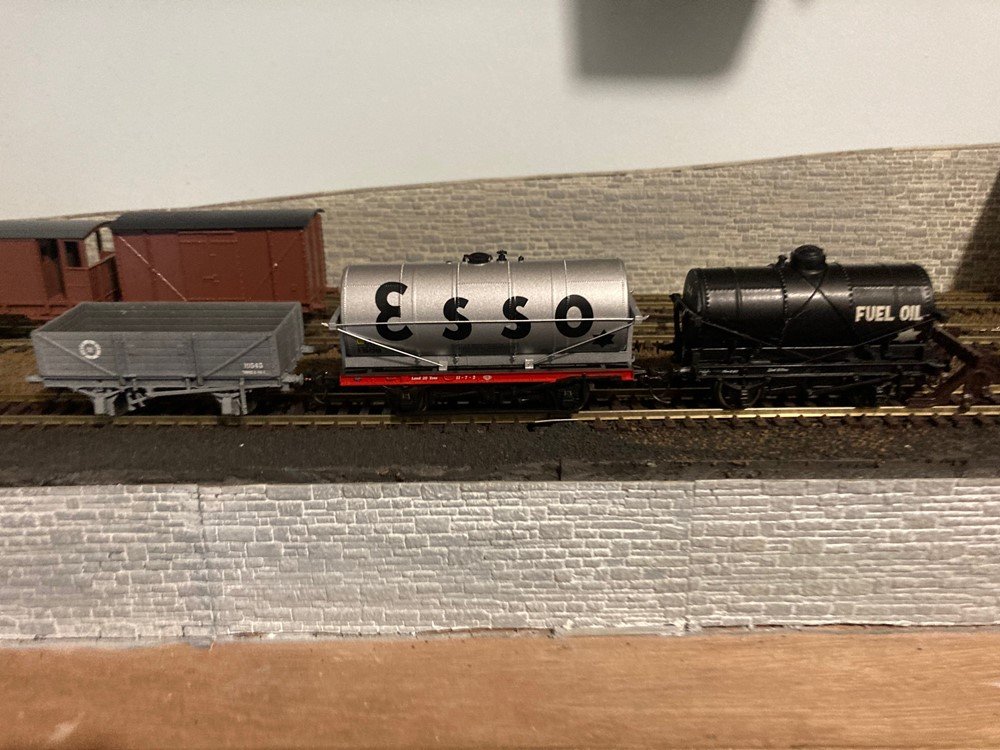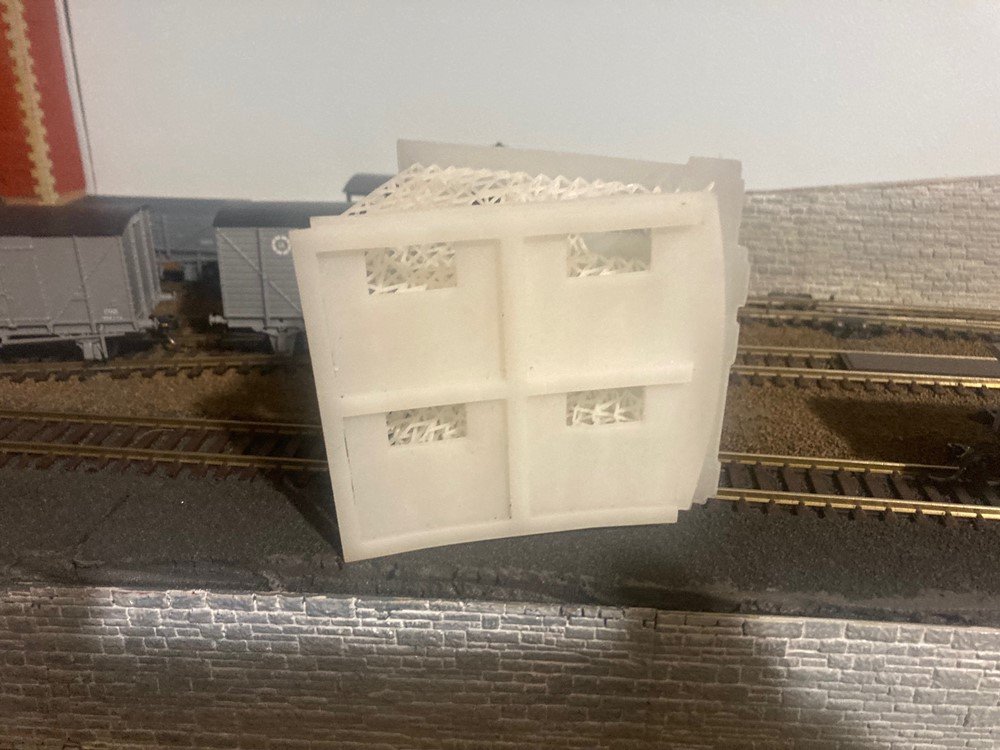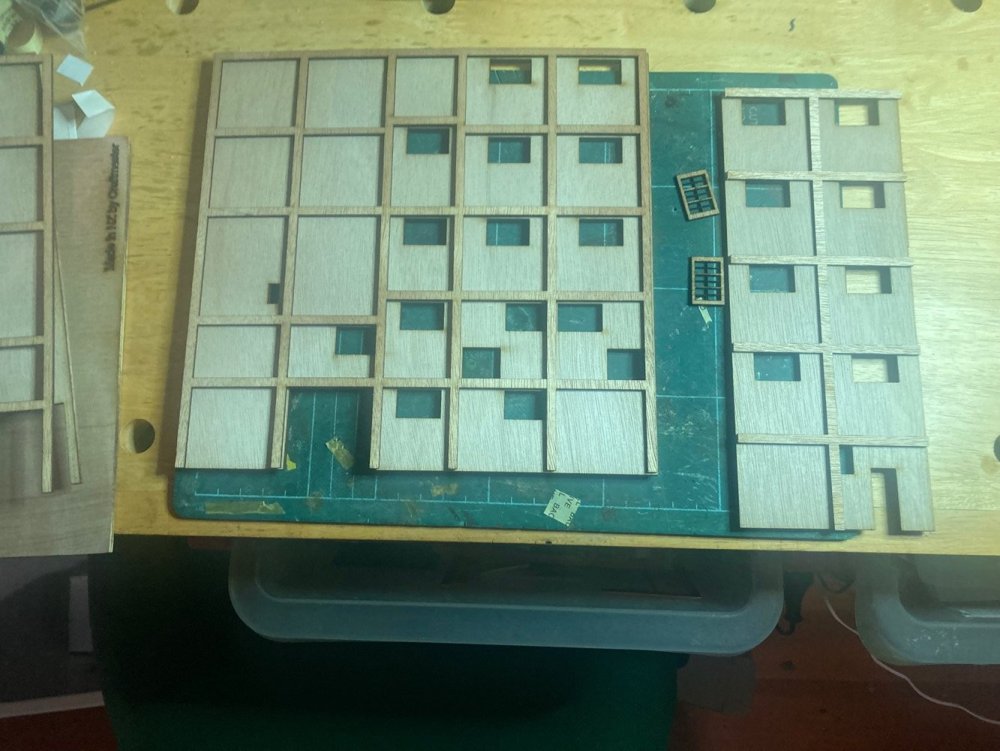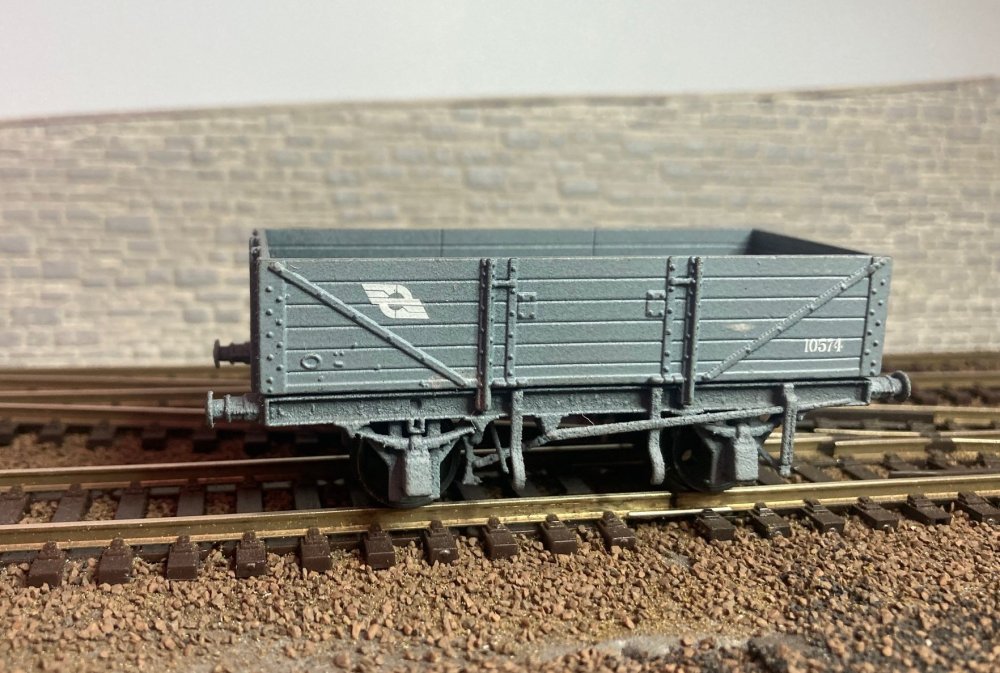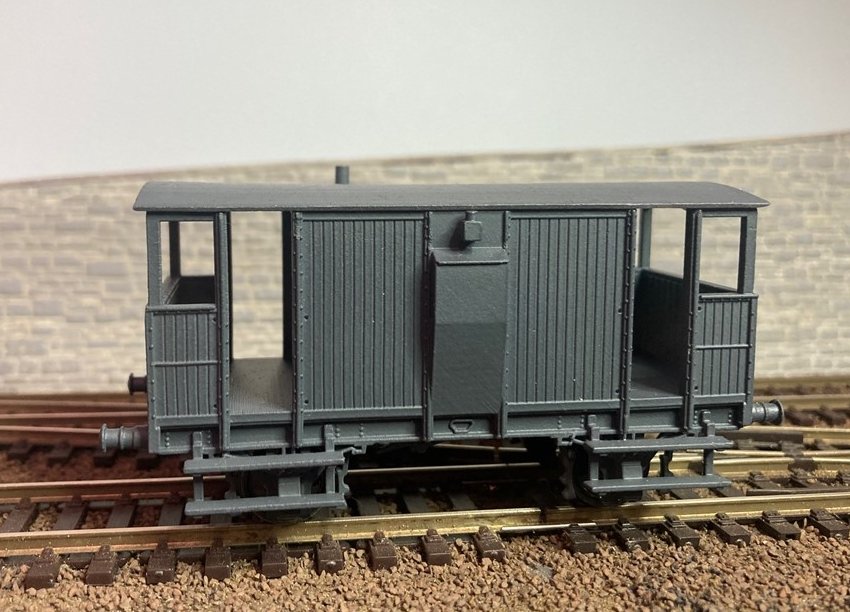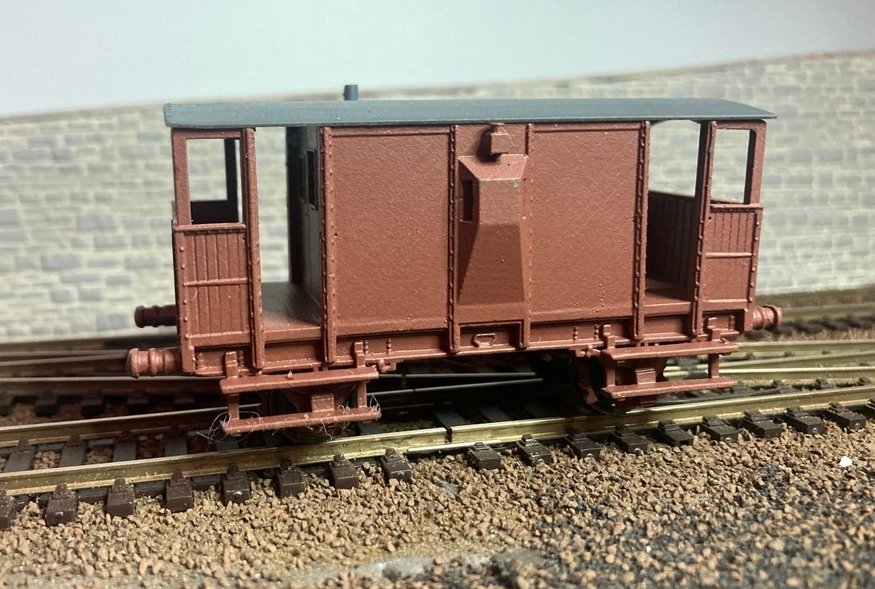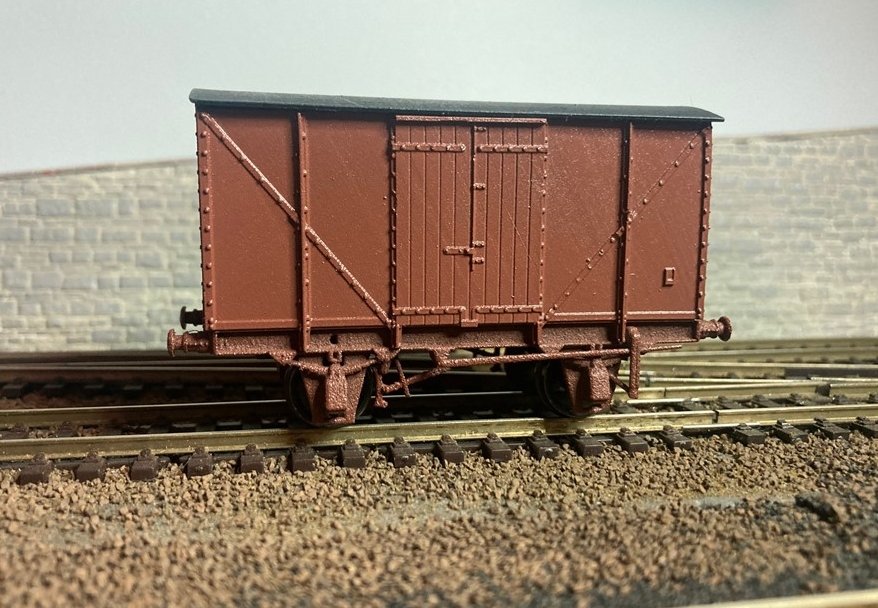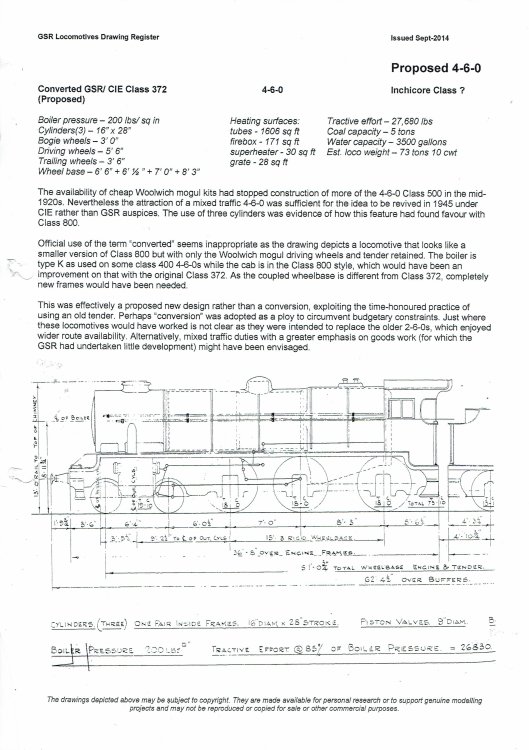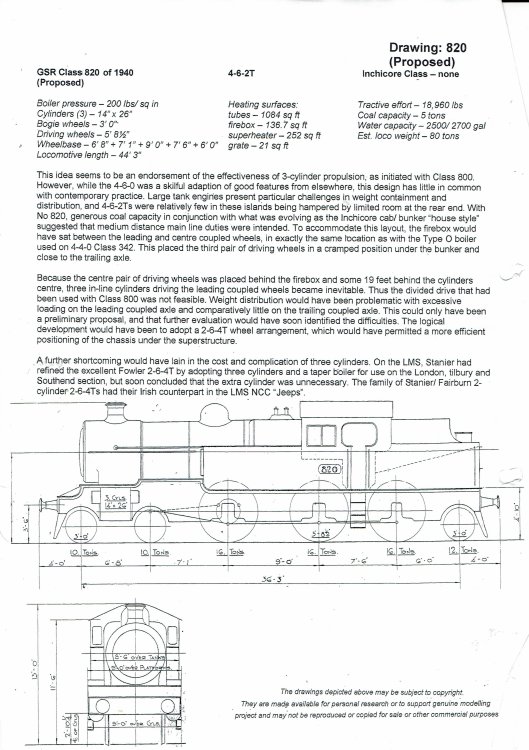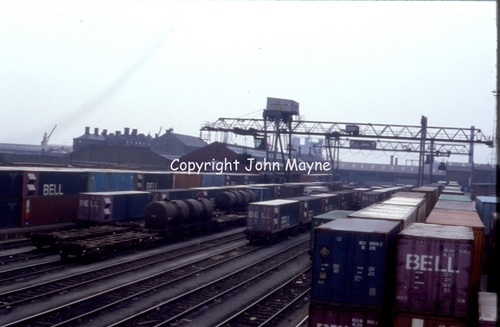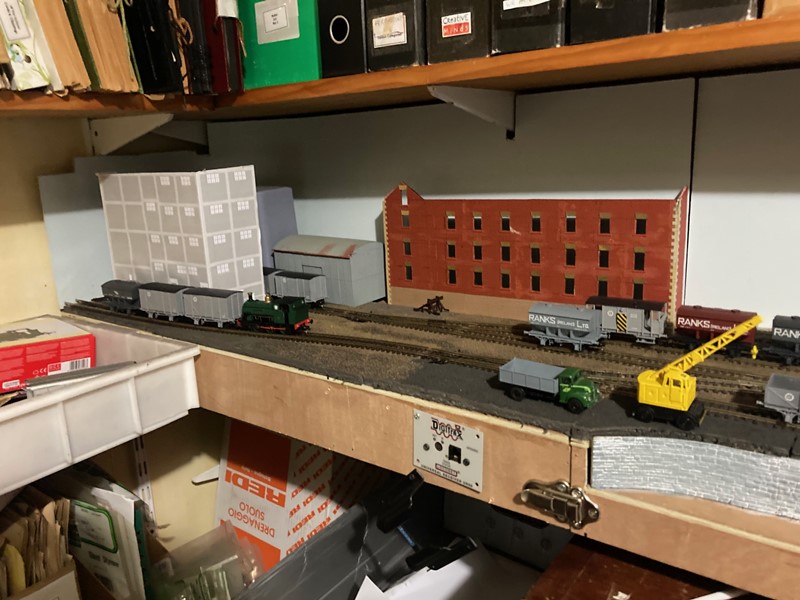-
Posts
4,879 -
Joined
-
Last visited
-
Days Won
119
Content Type
Profiles
Forums
Events
Gallery
Everything posted by Mayner
-
I did a partial re-paint of a Bachmann "Fina" tank wagon to look more like an Irish wagon https://www.hattons.co.uk/23604/bachmann_branchline_37_658_14_ton_tank_wagon_in_fina_livery_140/stockdetail by masking the "Fuel Oil and star markings The Bachmann cradle and anchor mounted tanks are reasonably close to the wagons used by the "Irish" oil companies, main problem Bachmann does not appear to sell an-undecorated version of either type. The ESSO tank wagon is a Hornby (former Airfix/GMR) model similar in general outline to the type of wagon used by ESSO Teo before the arrival of the 'modern" Charles Roberts wagons in the late 60s. There is a video somewhere (Markle?) of a loose coupled ESSO Oil train leaving Sligo made up of several different types of wagon
-
Like most of my layouts Northwharf has been going through something of a hiatus as I lost interest after getting trains up and running despite the arrival of the Peckett in late January. The next challenge is to assemble the mill/grain elevator the laser cut parts arrived today! I originally looked at building the mill using 3D printed panels similar to the Design Preservation Models modules for American Industrial buildings, the down side was cost and warping of the 3D printed parts. The set of parts was prepared by Craftmaster a locally based model maker, complete with a very useful set of instructions. I reduced the height of the mill by one story in order to model the head house a prominent feature of the Westport Mill. I was particularly impressed by the laser cut windows with rather fine glazing bars. All I need to do is assemble, paint and weather the model
-
There are two options for shipping by DHL DTP (Delivery Duty and Tax Paid as offered by Hattons where DHLs customs clearance fee and the VAT is charged up front in the price. The second option is DHL DIP (Delivery in Place) where the customer pays the Customs clearance fee and VAT to DHL upon arrival. I have used both systems for shipping items >€150 to Ireland and the EU. The DIP option actually works out between €5-10 cheaper per order for the customer than the DTP option after paying the DHL fee and Vat upon arrival. Hattons include a margin in their pricing for the additional overheads in using the DHL DTP system and EU Vat registration/IOSS system, which adds to the total price paid by the customer. Royal Mail-An Post is the cheapest option for orders above €150 as the fee charged by An Post is a lot lower than DHL provided the overseas shipper uses the correct Taric Code. It would be worth checking with Hattons or other UK suppliers whether they offer a DIP rather than a DTP option shipping by DHL.
-
There is very little published information on Dublin and Meath locos, the best source is the IRRS library. John O'Meara published a paper on the history of the Meath Road in an IRRS Journal during the early 1950s and GR Mahon published a series of papers during the 1970s on developments on Irish Railways during the 1860-70s which included info on the Dublin and Meath and disposal of its locos and stock. The D&M locos and stock appear to have been acquired under a hire-purchase/leasing agreement with the "U K Rolling Stock Company" a 19th Century equivalent of a modern Vehicle Leasing/Finance Company One loco D&M No7 an 1862 Fossick & Hackworth 2-4-0 nicknamed 'Drag all" was absorbed into MGWR stock and re-numbered No 11 Meath when the Midland took over working of the line in 1869, some of the other locos and stock appear to have passed to the Athenry and Tuam. By all accounts 'drag all" was considered the only D&M loco to be in reasonable working order. The Navan-Kingscourt appears to have been worked by the MGWR from the onset with the line opening to Kilmainhamwood in 1871.
-
The RPSI flickr collection is probably one of the best sources of station, rolling stock and loco photos, access to the collection is well worth the subscription in itself. There are a couple of photos of Trim and the branch Boyne viaduct in the IRRS flickr collection. The station building was demolished, but the goods store still standing when I griced the line during the 70s/80s.
-

Ernies Massive Irish 1930's to 2005 Photo Archive
Mayner replied to Glenderg's topic in Photos & Videos of the Prototype
500s train is likely be a Dublin-Cork mail train with through portions to Limerick (via Ballybrophy), Clonmel (via Thurles), Tralee (via Mallow) and Cork. CIE also operated a combined Kingsbridge-Limerick-Thurles train with a Clonmel coach which divided at Ballybrophy. Sometimes the train loco continued to Limerick while the Thurles-Clonmel branch loco (usually a large Coey 4-4-0) worked the Ballybrophy-Thurles-Clonmel portion of the train often an ex-GSWR 12-wheel "Rosslare" Brake composite. (Decade of Steam Donaldson, O'Neill and Mc'Donald 1RRS 1972. The coaches in the train appear to be relatively modern by the standards of CIE steam hauled stock during the early 1950s, the new 1951-53 stock were mainly used as trailer vehicles with the AEC railcars or used to strengthen late GSWR/GSR stock on mail line passenger trains. The Bogie Van coupled to the loco appears to be a 1920s woodenbodied GSWR/GSR vehicle, CIE did not get round to building "modern" bogie vans until 1959. -
The Heljan Ruston is based on the RH 165DE Class 0-6-0s diesel electric locos supplied to BR Western Region permanent way dept. The Tuam loco was a standard RH 165DH a diesel hydraulic 0-4-0 supplied to CSE. The RH 165 DE & DH were manufactured in 0-4-0 & 0-6-0 format The main spotting difference between the DH & DE versions was the coupling rods were driven by a jackshaft arrangement (behind the cab steps) on the diesel hydraulics. The Heljan loco has the raked cab front fitted to later later versions of both DH & DE locos.
-
CSE had RH 88DS shunters at the Carlow, Mallow and Thurles factories, Tuam had one of the larger more powerful 165DH locos. The 88DS at the various plants appear to have been supplied in an all plain green livery with red buffers, the individual plants developed their own variations of the livery as locos were re-painted/overhauled. There is a 1960 in photo of the Carlow DS and Sugar Puff No3 in service at the factory in Irish Railways in Colour a Second Glance. The 88DS is in overall green (including chassis) with red buffers (including head) but no running number or cabside RH makers plate. The photo is interesting showing the diesel coupled to an Bulleid open and H Vans loaded/waiting loading outside the plant. Besides receiving beet, coal and limestone, beet pulp and the finished product was sent out by rail during the wagon load era for both the domestic and export markets. IRRS journals from the early 70s indicate that Carlow and other factories regularly shipped train loads of export sugar in 8'6" Containers on (20' Flats) as out of gauge loads. When acquired from CSE the RPSI 88DS had green cab and engine housing on a black chassis with red buffer shanks and "Cómhlucht Siúicre Éireann" in gold lettering immediately above the access panels on engine housing. My 88DS a long discontinued Impetus kit is based on a 1980 photo of the loco at Whitehead, my unsuccessful attempt at Cómhlucht using dry print lettering is just about visible on the side of the bonnet. My locos was built to 21mm gauge hence the wheels outside the track
-
Andy's combination of London Road LNWR Special Tank and DX splashers with 5'2" wheels is probably the best option for building a DNGR Tank. I tried building a DNGR tank using a whitemetal GEM LNWR Special Tank and a brass chassis using Alan Gibson main frames, the model was not a success as I could not get sufficient clearance for the larger wheels in the whitemetal kity body and I was not too impressed with the quality of the castings. Richard Hobbs produces a Shapeways 3D printed GNR JT 2-4-2T which can be finished to a reasonable standard using plasticard overlays to the sidetanks https://www.shapeways.com/product/322AX6GR7/4mm-scale-gnri-jt-tank-body-shell-16-5mm-gauge, A OO Works UG 0-6-0 would pass muster on the goods, for those with a bit more determination Studio Scale Models produce an AL 0-6-0 and a PP4-4-0. ALs would have worked goods and cattle trains after the GNR took over working the DNGR during the 30s, PPs could have appeared on Greenore-Belfast Boat Trains and excursions to an from different parts on the GNR. The beauty of a relatively small but busy terminus like Greenore is that you don't need a lot of locos or stock to operate the layout, 2-3 DNGR Tanks, a GNR 2-4-2T, a couple of 0-6-0 to work the goods and cattle specials, half a dozen 6 wheel coaches and 20 or so wagons, being a junction terminus with lines to Newry and Dundalk considerably increases to operating interest compared with a typical Branch Line terminus 6-12 months spent assembling/building a loco kit such as an AL or PP does not add up to a major commitment in terms of time or money.
-
I always thought the as-delivered gray and yellow B121 colour scheme was reasonably practicable like other 1960s "dip job" schemes distinctive and cheaper to apply than the later Black and Tan and Supertrain schemes. For many years the Louisville & Nashville, the Clinchfield both coal hauling railroads and their successor CSX painted their locos in a light (Confererate) Gray livery similar to the as delivered B121 Class. The Clinchfield was a steeply graded mountain railroad with many tunnels, while the Mid West/Eastern US climate tends to be drier with less rainfall than Ireland, US locos tend to be covered in a coat of grime in winter time While the 2 stroke General Motors locos like the Clinchfield F Units did not produce much smoke 4 stroke locos like L&N General electrics like 1481 could put out as much black smoke or clag as a steam loco.
-

Ernies Massive Irish 1930's to 2005 Photo Archive
Mayner replied to Glenderg's topic in Photos & Videos of the Prototype
The 'modern' coaches appear to be former Drumm Battery Train C or D which were converted to hauled stock in 1953/4 after the removal of the batteries and electrical equipment. -
Nice to see the WLWR coaches scratchbuilt in plasticard. I attempted coach building in plasticard in the 80s but at the time was put off by cutting out the lace like beading on the majority of panelled coaches. Its possible the Dublin & Meath Brake vans passed into WLWR ownership. The Athenry and Ennis operated its line (an the Athenry & Tuam) with ex-D&M locos and stock before the Waterford and Limerick took over working of the lines North of Ennis. The Athenry and Ennis appears to have been in a similar financial situation to the Bishops Castle Railway using hand me down locos and stock and the County Sheriff (Galway or Clare?) at one stage seizing the train. G R Mahon published a series of articles in the IRRS Journal during the 1870s which provides an annual review of Irish Railway activities during the 1870s including the working of the Ennis and Athenry with ex-D&M locos and stock.
-
We have resumed production of 3D printed wagons, a number of variations of GSR/CIE Covered Wagons (H Vans) available to order from our web site. https://jmdesignmodelrailways.com/. While a small quantity of Covered Wagons are available from stock, I am planning to introduce a pre-order system to assist in our production planning and respond to demand. We have been unable to identify a supplier capable of printing wagon chassis in a resin with similar resilient characteristics to our original supplier, our wagon chassis are now printed in a nylon material using the SLS process for its strength and resilience, our wagon bodies are printed in a detail plastic using the SLA process because of its visual process. While the SLA process used by our new supplier is capable of re-producing finer detail than our original supplier, the trade off is that the detail resin is rigid and brittle and not really suitable for wagon chassis. The SLS process used in the chassis results in a slightly coarse finish when viewed in close up. New Models: planned release July 2023. We produced test prints of new models including 2 variants of the Brake Van and a variant of the GSWR van while out of production, but there was little point in ordering decals until we resolved our printing problems. 20T Brake planked body with sheeted duckets. Based on an early 70s photo of 23544 the ducket sides covered in sheet metal. 20T Brake Van, Cabin sheeted in plywood, with pressed metal duckets, planked balconies. Based on a photo of 23508. 10Ton ex-GSWR/GSR 10T Covered Wagon aluminium body sheeting planked doors. Based on an early 70s photo of 15653 I am planning to prepare decal sheets for these wagons with additional running numbers, but currently only have one running number for each type! I would appreciate it if anyone can provide further running numbers of these variants.
- 11 replies
-
- 14
-

-
The GSR developed a obsession with 3 cylinder locos during the late 30s early 40 including a "rebuild" of Woolwich Moguls as a 3 cylinder 4-6-0 and a 4-6-2T for the Kerry Road. The 372 Class rebuilds may have been intended for the Midland, where the Woolwich were overloaded on Dublin-Galway Passenger/Mail trains. The rebuilds were intended to combine a 400 Class boiler with Woolwich driving wheels & 800 class motion the Irish equivalent of a "Baby Scott" the 3 cylinder drive would have been less severe on the track than the 2 cylinder Woolwich and 400 Class rebuilds. The 820s were based on the boiler used in the Rosslare "Bogie" 4-4-0s and in a way is an update of an early GSR proposal for an outside cylinder 4-4-2T for the South Easter with an additional set of driving wheels. There was little or no prospect for the development of new steam classes after the Emergency the CIE Chairman quickly convinced the Board that dieselisation was the way forward. The First Diesel programme included proposals for a luxury "Diesel Tourist Train" to promote Ireland as a tourist destination and a single ended diesel not unlike an American A unit, the First Diesel programme failed because the UK manufacturers did not have the capability to take on the CIE order in the immediate post war era, CIE instead ordering engines and electrical equipment for 5 Diesel Electric shunting locos with Mirrlees engines and Brush Electric Equipment, 2 Mixed Traffic diesel electric locos with Sulzer engines and Metropolitan Vickers Electric Equipment and 6 Large Diesel Electric Locos for Kingsbridge-Cork services powered by two Sulzer Engines with Metropolitan Vickers Electrical Equipment. The CIE Chairman was forced to resign and the order for the 6 large diesel electric was cancelled as a result of political pressure, the engines and power units were stored and later used in the B101 Class possibly the most reliable and useful of the CIE 'modernisation era' classes of main line diesel locos.
-
It might be worthwhile contacting the Ulster Transport Museum. An Outline diagram of the 0-6-4T is listed as Diagram/Sheet 9 in a 1990s Ulster Folk and Transport Museum list of BCDR Loco drawings.
-
Strictly speaking the 4-6-0s are unlikely to have hauled trains of modern coaching stock during CIE days apart from the GNR stock on the short lived Amiens St-Cork leg of the Enterprise. Main line steam hauled trains were mainly made up of early GSR/ late GSWR corridor coaches with the odd 'modern' GSR or CIE Bredin coach in the rake. The Bachmann/Murphy Models "Irish Passenger Train" coaches are close in outline and general appearance to the early GSR/late GSWR coaches, Silver Fox CIE 1951-3 Composite would pass for a GSR or CIE Bredin coach (from a distance!) The early GSR/late GSWR coaches would have been considered state of the art (though the 3rd Class a bit spartan) when the 400 and 500 Class 4-6-0s were introduced in the 1920s The CIE 1951-3 stock which included Corridor Composites, Corridor Thirds, Open Thirds, Brake Thirds and Buffet cars were used principally as trailer coaches for use with the AEC Railcars, with the odd vehicle used to provide a 'modern coach' in steam hauled trains. The Laminates were introduced in the Silver Livery from 1956 onwards after steam was withdrawn from main line passenger services. Some Laminates were painted in light green with the single eau-de-nil with the flying snail logo in the late 50 early 60s. The Laminates were quite different in construction and outline to the 1951-3 stock The 500 & 501 were withdrawn in 1955 following the introduction of the A Class diesels, 503 was withdrawn in 57. The 800 and 400 Class were relegated to secondary duties (mainly goods trains) following the introduction of the A Class, the majority of the remaining 4-6-0s were withdrawn between 1955 & 58. 401 & 402 were withdrawn in 1961 and 800 in 1962.
-
The Virginian and Ohio and Tony Koesters "Allegheny Midland" were inspirations when I took up American outline modelling in N gauge during the 90s though I never had the space to go beyond a folded 8 in the attic of our house in Dublin. Hopefully I will get to see the coal hauling railroads that inspired the V&O when we visit friends in the Appalachian Mountains in June
-
One of my last construction projects in Ireland had buildings with curved walls and other interesting architectural features, involved a lot of technical challenges and took a lot longer to build than "normal' buildings, but turned out well and became a local landmark in the end. Down the years I have used American N gauge rtr and Large Scale (1:20.3) rtr to get something up and running quickly as a diversion from my Irish Broad and Narrow Gauge modelling or I simply wanted to play trains and get away from the research and scratch/kit building.
-
The 500 Class were one of the first successful classes of modern Mixed Traffic 4-6-0s in the British Isles the nearest preceding the much larger GWR Hall and LMS Black 5 Classes. The 500 Class cylinder and valve gear arrangement was used as the prototype for re-building 40o Class from a 4 to a 2 cylinder loco, unfortunately only 402 received the full rebuild with new-frames and 500 Class motion on the grounds of cost. Although it was apparently planned to build further members of the Class, Inchacore only built three 500 Class 4-6-0s, the purchase of an additional 16 sets of parts from Woolwich Arsenal was a much cheaper option. Probabably have to be a scratchbuild, there is unlikely to be enough demand for a rtr model or a kit of a relatively small obscure class that had all gone by the mid-1950s
-
Railway/transport companies such as CIE/NIR/Ulsterbus tended to carry out heavy maintenance work including engine/generator overhauls in house up to the early 90s when it became fashionable to outsource-maintenance. Visited Inchacore works a number of times during the 70s-80s diesel engines were overhauled-re-built in house, engine/generator overhauls were outsourced to 'approved suppliers' in recent years, cuts down on the number of highly skilled maintenance staff and parts inventory, same principal applies with modern railcar maintenance. Proabably best to contact the RPSI or some of their carriage volunteers, they have a Dutch Van 462 and to MK2 Brakes fitted with Generators https://www.steamtrainsireland.com/rpsi-collection/82/462-dutch-van
-
The F G Wilson genset in the Downpatrick generator van is a modern portable Generator Set and quite different to the generator sets used when the vans were in CIE/IE service. The CIE/IE generator van fleet went through engine/generator changes during the life of the vans as engines/generators wore out. Its likely that BREL (British Rail Engineering Limited) was likely to have been involved in the specification and supply of the generators originally supplied with the BR Vans, MK2d (Supertrain) and MK 3 coaches, possibly Perkins or Leyland. The generator vans may have been fitted with "Detroit Diesel" generator sets during the 80s as a result of CIEs bad experience with Leyland engines in its Atlantean Bus fleet during the 70s. The 2 stroke Detroit engines were reliable but thirsty, possibly leading to a shift to the more economic Cummins Engines during the late 80s/90s. One of the most noticeable thighs about CIE/IE trains during the loco-hauled era was that the generator vans almost created as much noise as the loco.
-
Had a similar experience matching BR Bauxite for re-painting a Goods Brake on a UK heritage line during the 90s. The paint mixed to a BR spec. was almost a salmon pink when initially re-painted, but faded/cured to the correct shade after a year or two. Going back to Sperry, does anyone know whether IE are retaining Sperry for (ultrasonic?) rail testing or appointing another contractor? In the States Sperry were famous for its fleet of self propelled Inspection Railcars usually converted gas-electric "Doodlebug" dating from the 1920-30s similar to SRS 119 https://www.sperryrail.com/rail_inspection_sticks.php which roamed the US rail system.
-

Question about LYONS Container "road number" or "running number"
Mayner replied to MAL's topic in Irish Models
ISO Container data including "running number" is usually displayed on the end door rather than the side of the container. The CIE 20' Side Door containers on 4w flat wagons were sometimes used as conventional vans loaded through the side doors at goods yards during the final years of loose coupled goods trains, a number on the side of the container/van would have been helpful to depot staff. I suspect that the "Lyons Tea" containers were owned by CIE, the containers/wagons in the Inchacore photos (mid 80s) appear to have been in use a 'stores vans" for storing/moving parts between Works and Loco depots. -
699 is listed as a 3rd Brake one of a batch of 9 coaches built in 1894 in Richards and Pender GSWR carriage diagram book. The 9 coaches were originally built with Birdcage lookouts above the guards compartment a distinctive GSWR feature. I bought a copy of a GA of a WCIR 4w 24' 2nd dating from the 1880s from the HMRS, I will draw up a diagram when I get a chance, the panelling detail is unusual and quite distinctive. There is also a WCIR 6w from the 1890s listed on the HMRS site it would be interesting to see whether they are the same or a different design to 600-601
-
Northwharf/East Dock is a good example of how I loose interest and my layouts go into a kind of hiatus once I complete the trackwork and can actually run trains, same happened with my Irish 3' gauge Keadue layout and the Garden railway with little or no running during the past year. Decided to finalise and complete the buildings and structures not quite a New Years resolution, one of the challenges was to finalise the mill/grain silo end of the layout originally planned as a siding serving a loading bank for general goods traffic and grain silo served by an extension of the running road/engine release. I trialed a mock up of the mill/silo at Westport Quay as the main structure with a corrugated iron dry store in the background to balance the Tower Building and overbridge at the fiddle yard end of the layout. The proportions of the mill are based on a storey height of 9' for the upperfloors, though I removed the top storey in order to model the elevator "head house' a distinctive feature of this type of structure. The silo will have one spot for loading/unloading bulk grain wagons and two vans which should keep the Peckett busy shunting while the main-line loco basically works complete trains between Northwharf and the fiddle yard and performs the run round. I looked at a number of options for constructing the silo including 3D printed wall panels but decided on a laser cut ply structure for strength and stability, next big job is to complete the brick and stone maltings building I origonally started in 2012/3
- 56 replies
-
- 10
-

.png.c363cdf5c3fb7955cd92a55eb6dbbae0.png)


